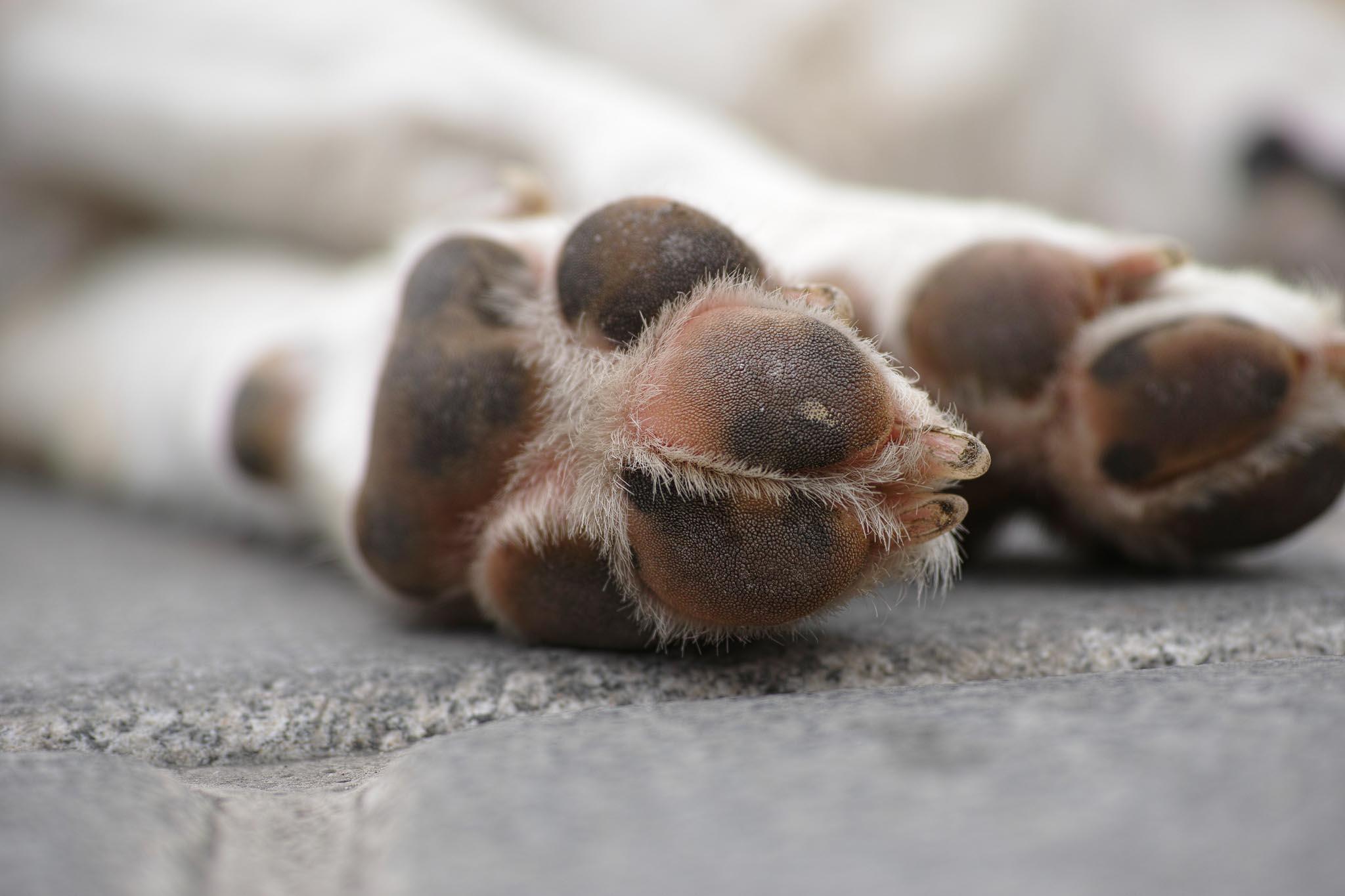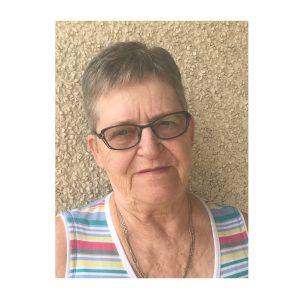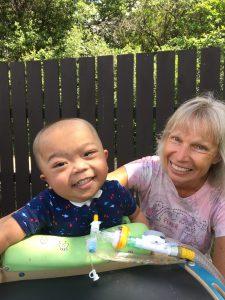Her Royal Highness “Princess Callie” and her courtier Jim are well known in the Prairie Hospice Society community. Together they do a lot of volunteering, and “the princess” has become something of a star. However, Callie wasn’t always treated like royalty; she was originally a rescue dog from the Prince Albert SPCA where she’d been since she was six months old. “She was there for a year,” says Jim. “They don’t normally keep dogs there that long but nobody wanted her. The SPCA people knew what a good dog she was, but people don’t want black dogs, and mid-size ones.” That is, until Jim and his wife Vicki met her nine years ago, and Callie found her forever home. Since then, she’s become a light in their lives, as well as in many others’.
You see, Callie is now a certified Therapy Dog, and she accompanies Jim on many of his volunteer jobs for different groups. When she first came to Jims household, Jim was volunteering at Elmwood Residences, a support organization for people living with intellectual disabilities; Jim and Vicki’s adult daughter lives there. “When I was president of Elmwood and I was going in every day, I used to take Callie with me, and I’d ask to leave her with the Cosmo Industries – Elmwood Seniors program just down the hall,” says Jim. “And she was just perfect – she’d sit beside wheelchairs, she didn’t react or anything – and I realized she’d make a perfect therapy dog. So I went and had her certified with St. John Ambulance … it’s not very hard, but you have to have the right dog. I didn’t have to do any training with her at all, we just went and took the test – they look for whether the dog startles with wheelchairs or walkers or people with palsy … how do they react to people. She’s just really calm, it’s nothing to do with me, she just came that way.” Because Jim was also a Kiwanis Club member, Kiwanis sponsored Callie to be a St. John Ambulance therapy dog. Kiwanis donated $500 to the Therapy Dog program, and Callie received a red Therapy Dog vest with the Kiwanis Club logo on it.
In 2015, Jim completed his volunteer training with the Prairie Hospice Society (PHS). And it occurred to him that it might be nice to bring Callie along on some of his visits. “It seemed a natural fit to blend the two programs,” he says, “so I wrote letters to both boards [PHS and St. John Ambulance] and it got approved by both. Prairie Hospice was all for it. So now Callie is certified to do hospice work! As far as we know she’s the first dog in the province to have this designation.
“And she really loves it, I’ll show you,” says Jim. Callie is sleeping on her dog bed when Jim goes to get her vest from the cupboard. She realizes what he’s doing, jumps up, and runs to him. She is visibly excited, clearly pleased, as he puts her red vest on her. At the risk of anthropomorphizing, she is one proud dog.
Jim is active in the Hospice Now program, which supports the sporadic but more immediate needs of PHS clients – driving them to appointments or to do errands, or shovelling out their driveway, or boosting their frozen car battery, or walking their dog. “When I take Callie on Hospice Now trips I take the truck and she’s in the back of the truck, the people are usually in the front seat,” says Jim. “She always sticks her head up and says ‘Hello’ and then she lays down. But it gives people something to talk about other than the treatment they’re going to, or how their health is. When you do Hospice Now, you get some weeks with four or five different people to drive if you have the time – there’s just a demand for it, you could do it full-time if you wanted to – and you meet a variety of people. So Callie’s come along and met Prairie Hospice clients.”
Jim has also had three companion clients in the Hospice Without Walls program, and he speaks about each of them admiringly, as friends. “I have one client at Samaritan Place that I go in and see once a week, and Callie just loves going there. My client doesn’t talk to anybody – he doesn’t talk anymore, there’s all sorts of reasons for that, and he doesn’t interact with people very well. So I’d go talk to him and his wife for an hour, and I asked him if I could bring the dog. Well he started to show some interest and Callie showed an interest in him so I’ve been taking him for walks in the wheelchair and he holds her leash. He’s obviously responding to her and she’s responding to him. She goes and visits other people there once in a while but she really focuses on him, she loves those little walks.”
The wife of another of Jim’s clients would sit in the back seat of the truck when taking the client to the hospital or appointments, and talk to Callie. She would bring Callie treats. Sadly, she suddenly died of brain cancer at Christmas time; over those holidays, Jim and Callie took her husband, Jim’s client, out pretty much every day to help him get through it. Jim is still his regular companion.
Jim, now 75 years old, was a Professor of Physical Education at the University of Saskatchewan for more than three decades. He was hugely involved in speed skating. Since retiring 14 years ago, he’s thrown himself into the volunteer sector. “I volunteered lots before too,” he says, “but always at a leadership level. I was president of Elmwood, chairman of that board; l’ve written ‘Racing on Skates’, the long-term athlete development program for Speed Skate Canada; I was a planner at the University, an international speed skating referee – I referreed the Olympics. I’ve been on boards forever – Association for Community Living, sport organizations, … but I had all these responsibilities and I found that my emotional cycle followed the project. When it was going bad, everything was bad and when it was going good, everything was good. I found I really didn’t want to be in a leadership role anymore. So I joined the Kiwanis Club just to be a member and I started seeing these opportunities through the Kiwanis Club, like with St. John Ambulance, and Prairie Hospice. I just want to do some direct service with less overall responsibility.
“I think it was also to pay back the community in a sense because my daughter, who is intellectually disabled, has been served really well by society. Many local families including ours have benefited from Saskatoon’s and Saskatchewan’s service to special populations and our youth. But it’s to pay it forward too. I’ve always felt that if we want to be treated well when we’re failing, we’re better off to get into the system before we fail. So that people have some history with you, so that they don’t just see you at your worst moments. I’ve always felt you need to get ahead of that curve.”
Because of his experience in so many groups and organizations, Jim has strong opinions about how to keep them viable. “With the volunteer sector in such decline, we all need to collaborate, we need to work together, we need to join programs and break down the bureaucracy – the legalities – and just get some things done,” he says. “Kiwanis Club helped with the Prairie Hospice fundraising at the Great West Brewery last July, the pancake breakfast went on for a week. Several club members, we all went down there and worked together – and I think that’s the key to the future. I suggested to PHS and KC that maybe we could collaborate on this, and work together in the longterm, in the future, so that if Prairie Hospice is doing something they can come to Kiwanis for volunteers and vice versa. I think that collaborative model is the only way forward. Prairie Hospice is good about reaching out, they were also involved with the Rotary Club in a lobster dinner.”
Jim points out that organizations like PHS survive solely on volunteers and private donors. “Base operating costs of PHS are substantial, and the organization does not receive any government money. That’s a crime! It’s nonsense, absolute nonsense,” he states vigourously. Such grassroots organizations must be incredibly resourceful to tackle the huge need with such meagre resources. “So with some good sense and some quietness and a little bit of the Saskatchewan way, you just go ahead. You go ahead and do what needs to be done and if you get caught you apologize,” he smiles. It’s that old adage: Don’t ask for permission, ask for forgiveness. “You do the best you can,” says Jim, “you pay things forward, and you get things accomplished.”
Asked what he gets out of his involvement with PHS, Jim doesn’t hesitate to answer: “Tremendous satisfaction. To be able to provide that little bit of respite for next to no effort, it fills your day. And sometimes it overfills your day!” he laughs. “So you get that sense of accomplishment. You do a couple of things in a day with Prairie Hospice, and no matter what else happens you’ve accomplished something. You’ve made a difference. At least you tried to make the world a little bit better of a place. These are little acts – and the kindness is reciprocal. There are days when I’ve gone to people’s places where I’m not sure I want to be there, but that changes as soon as you get inside. So it just makes you feel better.
“The other thing I get out of it is that I find these people absolutely heroic. They’re facing really serious physical challenges, they’re moving on, they address their life and where it’s at in a matter-of-fact way – with us they do anyway, I’m sure at night by themselves they get down. But they put on a good face and they carry forward. It’s absolutely wonderful.
“Volunteering for Prairie Hospice is so rewarding and absolutely the most satisfying thing I have ever done. I go into somebody’s home and give the caregiver two hours respite away from this 24/7 responsibility, or drive someone to and from an appointment. When they come back they are so appreciative of it, and they are so vocal, and so thankful – sometimes I am embarrassed because we don’t do that much.”
And of course, Princess Callie clearly loves being a part of it all too. The princess who has now gone back to sleep on her dog bed … but still with her precious red vest on.




